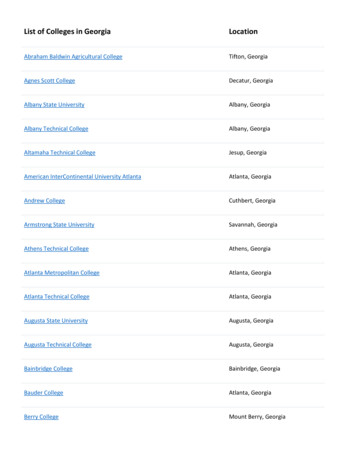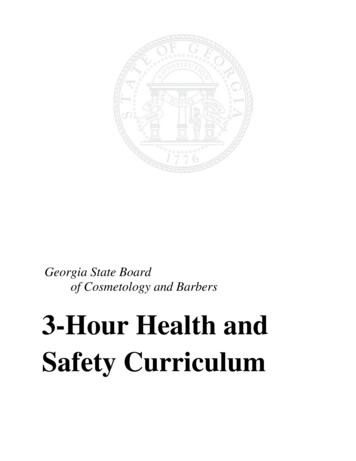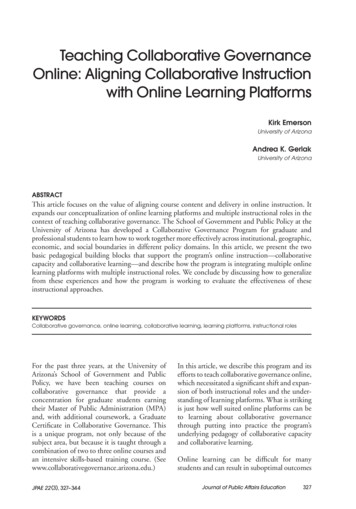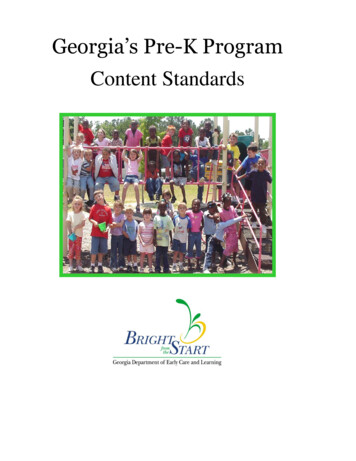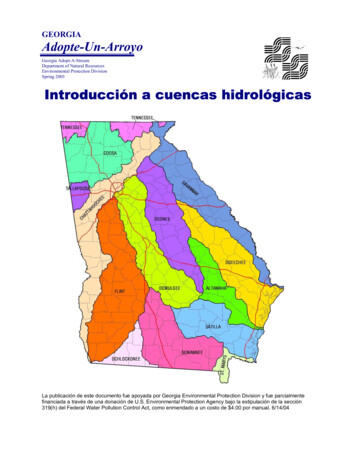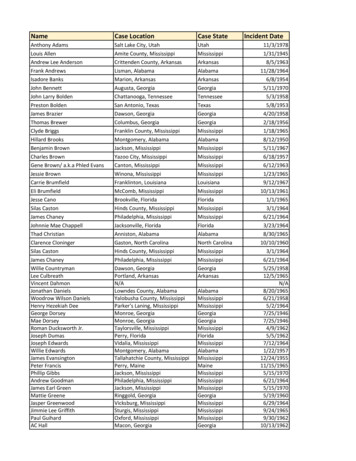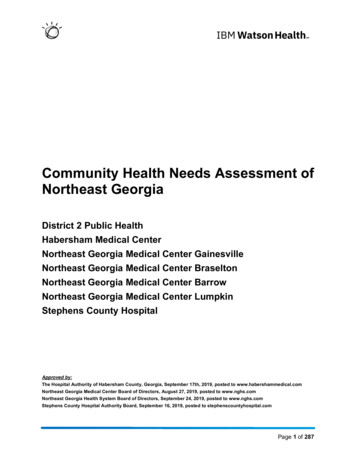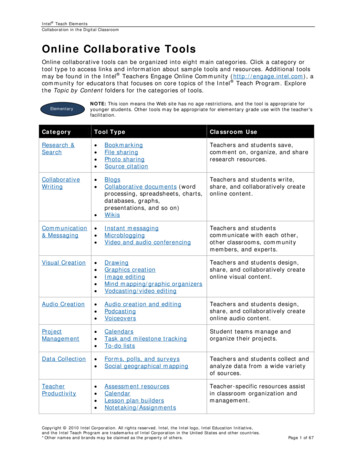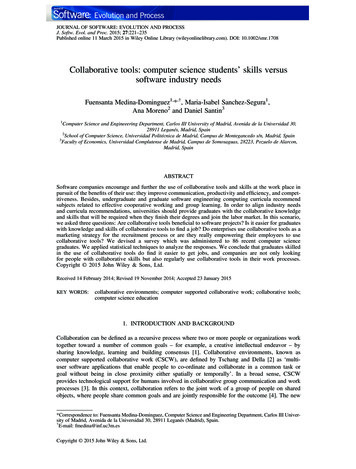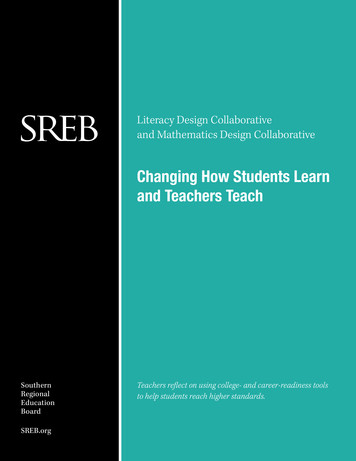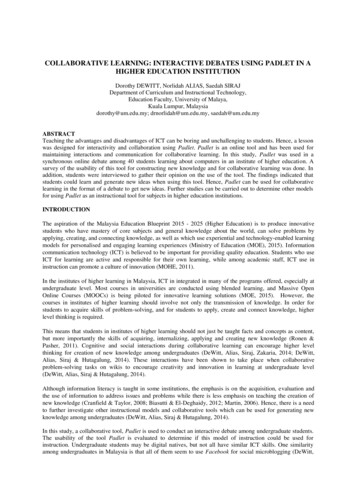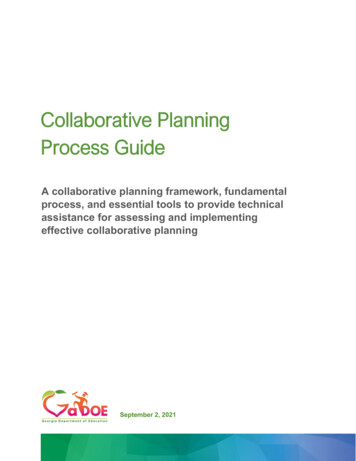
Transcription
Collaborative PlanningProcess GuideA collaborative planning framework, fundamentalprocess, and essential tools to provide technicalassistance for assessing and implementingeffective collaborative planningSeptember 2, 2021
Collaborative Planning Process GuideTable of ContentsOVERVIEW . 3PURPOSE . 3OBJECTIVES . 4GEORGIA DEPARTMENT OF EDUCATION (GADOE) STRATEGIC GOAL . 4GADOE’S COLLABORATIVE PLANNING FRAMEWORK. 5COLLABORATIVE PLANNING REVIEW PROCESS . 6Collaborative Planning Review Orientation Guide . 7Process Steps: Collaborative Planning Self-Assessment. 8Process Steps: Collaborative Planning Interviews . 10Process Steps: Collaborative Planning Observations . 13Directions for Microsoft Form . 15INSTRUCTIONAL COLLABORATIVE PLANNING PROCESS . 18Process for Implementing Instructional Collaborative Planning . 19Process Steps for School Collaborative Planning: Co-Teaching . 29COLLABORATIVE PLANNING REVIEW TOOLS . 31High Impact Practices Implementation Rubric: Collaborative Planning . 33Sample Email for Principal: Collaborative Planning Review . 45Collaborative Planning Observation Schedule Template . 46Collaborative Planning Interview Schedule Template . 47Collaborative Planning Review Interview Questions . 48High Impact Practices Tool: Collaborative Planning Observations . 49High Impact Practices Implementation Rubric:Collaborative Planning Self-AssessmentReflection . 52GADOE’S COLLABORATIVE PLANNING FRAMEWORK. 54COLLABORATIVE PLANNING TOOLS . 55Mission Statement Worksheet . 56Checklist for the Leadership Team: Collaborative Planning Structure. 57Strengths, Weaknesses, Opportunities, and Threats (SWOT) Analysis Tool . 67The Work. 68Deconstructing the Georgia Standards of Excellence 5-Step Protocol. 71Data Analysis Protocol . 76Vision Statement Worksheet . 79SMART Goal Worksheet . 80Georgia Department of EducationSeptember 2, 2021 Page 1 of 92
Collaborative Planning Process GuideSample School Collaborative Planning Schedule (Administrators) . 83Sample School Collaborative Planning Schedules (ES and MS) . 84Sample School Collaborative Planning Schedules (HS) . 85Goal and Action Plan Template . 86Improvement Project Work Plan . 88Georgia Department of EducationSeptember 2, 2021 Page 2 of 92
Collaborative Planning Process GuideOverviewThe Collaborative Planning Process Guide provides a framework to use when helping schooladministrators develop and monitor effective collaborative planning processes. This guideoutlines action steps and resources to effectively support school administrators in developingand monitoring collaborative planning.Purpose“The Georgia’s Systems of Continuous Improvement frameworkfocuses on the systems and structures (the “what”) that must bein place for sustained improvement in student outcomes. It alsoutilizes a problem-solving model (the “how”) to provide a clearprocess for identifying improvement needs, planning forimprovement, and implementing, monitoring, and evaluating theimprovement efforts.” 1 The purpose of this guide is to supplyschool leaders with a collaborative planning framework,fundamental process steps, and essential tools to use whenproviding technical assistance to schools or teams for assessing and implementingcollaborative planning. The collaborative planning process develops and assesses a school’slevel of implementation and effectiveness in three of the Georgia’s Systems of ContinuousImprovement (GSCI) 2: Coherent Instruction, Supportive Learning Environment, and EffectiveLeadership. Specifically, it focuses on the following structures: Planning for Quality Instruction – the structure of the instructional system in whichteams plan what the students should know and do, and determine how their studentswill show they know the content and can do a skill or performance taskDelivering Quality Instruction – the structure of the instructional system that guidesteachers in how they introduce content, practice its use along with the students, andthen allow students to use the content on their own while providing students regularstandards-based feedback to gain mastery of the contentMonitoring Student Progress – the structure of the instructional system thatmethodically discovers if the students are getting the content and what to do about itwhen they are getting it or are not getting it1Georgia Department of Education. (n.d.) Division of School and District Effectiveness. Retrieved l-Improvement-Services/Pages/default.aspx2Georgia Department of Education. (2017). Georgia’s systems of continuous improvement systems, structures, andschool improvement process. Retrieved from nd%20Structures%20Descriptions.pdfGeorgia Department of EducationSeptember 2, 2021 Page 3 of 92
Collaborative Planning Process Guide Refining the Instructional System – the structure of the instructional system thatexamines show to improve the planning for quality instruction, delivering qualityinstruction, and monitoring student progressCreating and Maintaining a School Climate and Culture Conducive to Learning –the structure of the leadership system that ensures that the school allows both adultsand children to put learning at the center of their daily activitiesCultivating and Distributing Leadership – the structure of the leadership system thatdevelops others to accomplish the group’s purpose and encourages the developmentof leadership across the organizationDeveloping and Monitoring a Tiered System of Supports – the structure of thesupportive learning environment system that provides comprehensive services tostudents to meet their unique, whole-child needsEnsuring a Student Learning Community – the structure of the supportive learningenvironment system that ensures compliance with positive and healthy behavioral andacademic normsObjectives Analyze the current state of collaborative planning using the resources in the processguideSupply tools to schools to assist with developing or strengthening the school’scollaborative planning process using the tools in the process guideAssess the collaborative planning structures as an ongoing practice using the HighImpact Practices Implementation Rubric: Collaborative Planning in the processGeorgia Department of Education (GaDOE) Strategic GoalGoal 5: Elevate districts, schools, leaders, and educators through high-quality, tiered,and tailored service, and support.Strategy: To enhance the Professional Capacity and Effective Leadership systems bystrengthening the teacher and leader pipeline and developing tools/resources that guidedistricts/schools through the continuous improvement cycle.Georgia Department of EducationSeptember 2, 2021 Page 4 of 92
GaDOE’s Collaborative Planning Framework 33American Management Association. (n.d.). Strategic Planning Seminar.; DuFour, R., DuFour, R., Eaker, R., Many, T.W., & Mattos, M. (2016). Learning by Doing: A handbook forProfessional Learning Communities at Work (3rd ed.). Bloomington, IN: Solution Tree Press.
Collaborative Planning Process Guide: Review ProcessCOLLABORATIVE PLANNINGREVIEW PROCESSGeorgia Department of EducationSeptember 2, 2021 Page 6 of 92
Collaborative Planning Process Guide: Review ProcessCollaborative Planning Review Orientation GuideWhy do we need effective collaborative planning?Collaborative planning provides teachers job-embedded professional learning to develop orstrengthen specific capacities to improve student performance. Specifically, it allows teachersto engage in practices that involve decision-making, lesson planning and design, instructionalmethods, data analysis (CCSSO, 2018), and learning environments. Most importantly, theprocess is ongoing and designed to sustain a clear focus of learning, create collectiveresponsibility, and emphasize evidence of student learning.Goals:1.2.3.To implement a common framework that all schools/districts and support personnel canuse to implement the components necessary to develop effective collaborativeplanning teams.To provide support and monitoring tools to ensure and guide schools/districts andsupport personnel in the improvement and evaluation of collaborative planning teams.All schools will reach operational status on the High Impact Practices ImplementationRubric: collaborative planning.Protocol Components:1.2.3.4.5.Complete a self-assessment. Faculty members will individually evaluate what theybelieve is the current level of practice of their collaborative planning team using theHigh Impact Practice Implementation Rubric: Collaborative Planning. The selfassessment will be administered using a Microsoft 365 Survey Form link provided to thePrincipal.Participate in an interview. All faculty members will be individually interviewed to assistin determining the level of operational status of the collaborative planning team.Conduct collaborative planning observations. Each collaborative planning team will beobserved twice. Evidence will be gathered to assist in determining the operationalstatus of the collaborative planning process.Prepare summary report. After the completion of the self-assessment, individualinterviews, and observations, compile and present a summary report to the principal.Presentation of the summary report to the collaborative planning teams. The principaland/or designee will present the review results to the collaborative planning teams.After the presentation of the results, the leadership team will collaboratively completethe Collaborative Planning Self Assessment Reflection form to determine action stepsto move the team toward operational or exemplary status in concepts scoring notevident or emerging.Georgia Department of EducationSeptember 2, 2021 Page 7 of 92
Collaborative Planning Process Guide: Review ProcessProcess Steps: Collaborative Planning Self-AssessmentBefore the Self-AssessmentContinuous Improvement Team ProcessI. Communicate with the Principal (in person) the purpose of the collaborativeplanning self-assessment Explain the three phases of the collaborative planning review processo Self-assessment: Explain the purpose and describe the procedures foradministering the self-assessmento Teacher interviews: Explain the purpose and describe the procedures forconducting the teacher interviewso Observations: Explain the purpose and describe the procedures forconducting the collaborative planning observations Share the High Impact Practices Implementation Rubric: CollaborativePlanning and the Faculty SurveyTool: High Impact Practices Implementation Rubric: Collaborative Planning High Impact Practices Implementation Rubric: Collaborative Planning (MicrosoftForms) Collaborative Planning Review: Faculty Survey (Microsoft Forms)II. Ask the principal to share all communication with their LEA supervisor.During the Self-AssessmentContinuous Improvement Team ProcessI. Conduct a Collaborative Planning Review orientation, upon Principal approval, tothe faculty.o Introduce yourself to the faculty, including the scope of your supportrole at the school, and describe the review process and purpose.o Provide the team with the Collaborative Planning Orientation Guide.Tool: Collaborative Planning Orientation GuideFollowing the Self-AssessmentContinuous Improvement Team ProcessI. Following the established close date for the survey, retrieve the data from theMicrosoft Office 365 form.Georgia Department of EducationSeptember 2, 2021 Page 8 of 92
Collaborative Planning Process Guide: Review ProcessTool: Collaborative Planning Review: Faculty Survey Responses (Microsoft Forms)II. Proceed to the next step of the review process: Collaborative Planning InterviewProcess.Georgia Department of EducationSeptember 2, 2021 Page 9 of 92
Collaborative Planning Process Guide: Review ProcessProcess Steps: Collaborative Planning InterviewsBefore the InterviewsContinuous Improvement Team ProcessI. Ask your DES to participate with the interview process and tocommunicate with district level personnel about the process and theschool(s) selected.II. Determine the number of team members needed to conduct the collaborativeplanning review based on the number of collaborative planning meetings in asingle dayIf necessary, recruit and provide an orientation to GaDOE and/orRESA colleagues on the collaborative planning interview process.Tool: Collaborative Planning Review Interview Questions Collaborative Planning Review Interview Questions (Microsoft Forms)III. Communicate with the principal (in person) the purpose of theinterviews.o Review the process,o Share the Collaborative Planning Review Interview Questions,o Decide who will be interviewed, ando Select a date for the interviews.Tool: Collaborative Planning Review Interview Questions Collaborative Planning Review Interview Questions (Microsoft Forms)IV. Ask the principal to share all communication with their LEA supervisor.V. Obtain the following:o Faculty list with content/grade level assignments and planning periodso School mapo Collaborative planning schedule and meeting locationso Collaborative planning non-negotiables and copies of requireddocuments/protocols (if established)o Bell scheduleo Teacher interview location(s)o Day of interviews - List of absent teachersGeorgia Department of EducationSeptember 2, 2021 Page 10 of 92
Collaborative Planning Process Guide: Review ProcessVI. Ask the principal for space(s) in the school and recommended timeslots to conduct the interviews and names of those to be interviewed.VII. Develop an interview schedule and send to the principal in an email formatthat can be shared with the interviewees. The email should include thepurpose and an outline of the process. Ask for feedback from principal andrevise if necessary.Tool: Collaborative Planning Interview Schedule TemplateVIII. Communicate the schedule, dates, location in the building, schooladdress and other logistics to colleagues assisting in the interviewprocess and to the principal.IX.Create or duplicate the Collaborative Planning Review InterviewQuestions (Microsoft Office 365 form) to electronically capture theresponses and send the link to the interviewers (if colleagues are assisting). Tool: Collaborative Planning Review Interview Questions (Microsoft Forms)During the InterviewsContinuous Improvement Team ProcessI. Introduce yourself to the interviewee, including the scope of your supportrole at the school, and describe the review process and purpose includingthe purpose of the interviews.II. Provide the interviewee a paper copy of the CollaborativePlanning Review Interview Questions.Tool: Collaborative Planning Review Interview Questions Collaborative Planning Review Interview Questions (Microsoft Forms)III. Ask each question as written and record the responses electronically in the formprovided, or you may choose to script the responses and record electronicallyfollowing the interviews.Avoid prompting or leading the interviewee's answers but answer anyclarifying questions posed by the interviewee.Georgia Department of EducationSeptember 2, 2021 Page 11 of 92
Collaborative Planning Process Guide: Review Process After the final question, thank the interviewee for their responses and timeand communicate to them how and when they will receive feedback throughtheir principal.Tool: Collaborative Planning Review Interview Questions (Microsoft Forms)Following the InterviewsContinuous Improvement Team ProcessI. Debrief with your colleagues if any assisted, making sure all informationwas entered in the electronic platformII. Before leaving for the day, communicate with the principal that interviewsare complete, provide informal feedback.III. Proceed to the next step of the review process: Collaborative PlanningObservation Process.Georgia Department of EducationSeptember 2, 2021 Page 12 of 92
Collaborative Planning Process Guide: Review ProcessProcess Steps: Collaborative Planning ObservationsBefore the ObservationsContinuous Improvement Team ProcessI. Ask your DES to participate and to communicate with district levelpersonnel about the process and the school(s) selected.II. Communicate with the Principal (in person) the purpose of theobservations and review the process, sharing the High ImpactPractices Implementation Rubric: Collaborative Planning and the HighImpact Practices Tool: Collaborative Planning Observations.Tool: High Impact Practices Implementation Rubric: Collaborative Planning High Impact Practices Tool: Collaborative Planning Observations (Microsoft Forms)III. Ask the principal to share all communication with their LEA supervisor.IV. Develop an observation schedule and send to the principal in an emailformat that can be shared with the teams. The email should include thepurpose and an outline of the process. Ask for feedback from principal andrevise if necessary.Tool: Collaborative Planning Observation Schedule TemplateV.VI. Duplicate the High Impact Practices Tool: Collaborative PlanningObservations form in the Microsoft Office 365 Forms application.o Create a copy of High Impact Practices Tool: CollaborativePlanning Observations form in Microsoft Office 365 Formso Enter the school name in the title of the copied form Communicate the schedule, dates, location in the building, schooladdress and other logistics to colleagues assisting in theobservation process and to the principal.Note: Stress the importance of district leaders participating in thecollaborative planning observations and working alongside the reviewteam.Georgia Department of EducationSeptember 2, 2021 Page 13 of 92
Collaborative Planning Process Guide: Review ProcessDuring the ObservationsContinuous Improvement Team ProcessI. Use the High Impact Practices Tool: Collaborative PlanningObservations form in the Microsoft Office 365 Forms application, toobserve and evaluate an actual collaborative planning meeting.o Compare the meeting proceedings against those attributeslisted in the High Impact Practices Tool: CollaborativePlanning. Document as follows: Concept Rating: Check the appropriate level ofimplementation in comparison to the rubric. Comments: Provide any positive comments relating theconcepts to possible best practices you may haveobserved. Use the rubric for guidance in crafting yourcomments. Next Steps: Provide doable next steps for the teamto consider, in order to improve their level ofimplementation on each concept.Following the ObservationsContinuous Improvement Team ProcessI. Debrief with your colleagues if any assisted, making sure all informationwas entered in the electronic platformII. Before leaving for the day, communicate with the principal and provideinformal feedback.III. Review the collaborative planning meeting schedule and secure a date for thesecond observation. Repeat the observation process.IV. Triangulate all three data sources to create the final CollaborativePlanning Review Summary Report which will include observationresults, collaborative planning interviews and the collaborative planningself-assessment data.V. Schedule a separate feedback meeting to review the CollaborativePlanning Review Summary Report with the Principal.Georgia Department of EducationSeptember 2, 2021 Page 14 of 92
Collaborative Planning Process Guide: Review ProcessDirections for Microsoft FormDuplicate form1. Click on the desired collaborativeplanning review tool (MicrosoftForm).a. HIP Rubric: CollaborativePlanningb. Faculty Surveyc. Interview Questionsd. Observations2. Click on the Duplicate it button(see screenshot).3. Click on the title: [Enter schoolname] Collaborative PlanningReview: Faculty Survey (Copy).4. Highlight Enter school name andtype the name of the schoolparticipating in the review.Georgia Department of EducationSeptember 2, 2021 Page 15 of 92
Collaborative Planning Process Guide: Review Process5. Click on Share to forward theform to the designated school.6. Click on the Copy button to getthe link to the form.Email form1. Open Microsoft Outlook.2. Click New Email.3. Place the cursor in the body of the email. Click Paste. You should see the link to theform.Analyze responses1. Click the Responses tab to access the results of the submitted forms.Georgia Department of EducationSeptember 2, 2021 Page 16 of 92
Collaborative Planning Process Guide: Review ProcessPrint Responses1. Click the Responses tab. Next, click the ellipses button ( ) under Active to printthe data based on submitted forms.2. Select Print summary.Georgia Department of EducationSeptember 2, 2021 Page 17 of 92
Collaborative Planning Process Guide: Review ProcessDownload Data to Excel1. Click Open in Excel to analyze results using Microsoft Excel.Instructional CollaborativePlanning ProcessGeorgia Department of EducationSeptember 2, 2021 Page 18 of 92
Collaborative Planning Process Guide: Instructional PlanningProcess for Implementing Instructional Collaborative PlanningProcess1Completeprework toestablishcollaborativeplanningContinuous Improvement Team Steps Discuss the purpose of collaborativeplanning with administration.Facilitate alignment of thecollaborative planning process withthe school improvement plan (SIP)and District Strategic Planning goals.Verify that the school district has aguaranteed and viable curriculum.Schedule, conduct, and share resultsof collaborative planning review ateach school.Facilitate professional learning on thecollaborative planning framework toschool leadership.Assist administrators in establishingexpectations for collaborativeplanning.Georgia Department of EducationSeptember 2, 2021 Page 19 of 92Key IdeasCollaborative Planning(CP) Framework –Leadership & Metrics:What methods will weuse?Structures for collaborativeplanning should include: Clearly articulatedcollaborative planningschedules (teacher andadministrator); Clearly articulatedexpectations; Clearly articulatednorms; and Clearly articulatedresponsibilities forfacilitators.
Collaborative Planning Process Guide: Instructional PlanningProcessContinuous Improvement Team Steps Assist administrators in establishingresponsibilities for collaborativeplanning facilitators.Assist administrators in establishingschedules for both teachers andadministrators.Assist administrators in establishing aprocess for developing and receivingfeedback on collaborative planningtools (i.e. agendas).Assist administrators in establishing aprocess for developing norms.Assist administrators in establishing atimeline for implementing eachcomponent of the collaborativeplanning framework.Key IdeasTools for collaborativeplanning should include: Agenda/minutetemplates Curriculum documents Data platform Technology resourcesSamples provided in thecollaborative planningresources are: Administrator and teacherschedules Meeting norms andexpectations Agenda and minutesexpectationsTools Checklist for collaborative planning23Write a missionstatement foreachdepartment/grade level.Collect andanalyzing data Verify that administrators review themission statements for thecollaborative planning teams andprovide feedback.Assist administrators with accessingthe tools listed below.CP Framework –MissionA mission statement isa statement of the purpose.It should be brief,measurable, and aligned tothe school’s mission.Tools Structure of a Mission StatementworksheetThe mission answers threekey questions:1. What do we do?2. For whom do we do it?3. What is the benefit? CP Framework –Needs Assessment: Whatis the current situation?Teams should list theexternal and internal factorsthat impact the currentAssist administrators with collectingand analyzing data that providesmeaningful information on teacherpractices, student achievement data,and collaborating planning processes.Possible data sources:Georgia Department of EducationSeptember 2, 2021 Page 20 of 92
Collaborative Planning Process Guide: Instructional PlanningProcessContinuous Improvement Team Steps GA MilestonesEOPA (HS only)AP, SAT, ACT (HS only)School/district summative dataWalkthrough dataComprehensive Needs Assessment(CNA)Key Ideassituation for/againstcollaborative planning inyour school/district.Note: The determination ofexternal and internal factorsis a brief activity to prepareteams for conducting aSWOT (strengths,weaknesses, opportunities,and threats) analysis.Samples provided in thecollaborative planningresources are:External factors Curriculum documentsAssessment item banksDistrict policies that arenot aligned to schools’needs (i.e. parentsconference duringplanning periods)Internal factors 4Conduct SWOTanalysis todeterminestrengths andweaknesses Support administrators withsummarizing the desired results ofcollaborative planning.Assist administrators with using the toollisted below.Support administrators with conductinga SWOT Analysis to brainstormstrengths, weaknesses, opportunities,and threats that support or impedeeffective collaborative planning.Georgia Department of EducationSeptember 2, 2021 Page 21 of 92Master schedule notallowing for sharedopportunitiesCP Framework –Needs Assessment: Whatis the current situation?Analyzing the strengths,weaknesses, opportunitiesand threats to collaborativeplanning provides data fordeveloping effectiveprocesses.Strengths – positiveattributes, tangible &intangible, internal to your
Collaborative Planning Process Guide: Instructional PlanningProcessContinuous Improvement Team StepsKey Ideas organization and within yourcontrolAssist administrators with includingteacher teams/departments inconducting a SWOT Analysis.Tools Template for conducting a SWOTAnalysisWeaknesses – aspects ofyour organization thatdetract from your ability todo the workOpportunities –internal/external factors thatallow you to do the workThreats – internal/externalfactors that are beyond yourcontrol5Establishexpectations forwhat studentsneed to knowand do Verify if a viable curriculum is in placeto support learning and studentachievement. If a viable curriculumis not in place, contact the DES fornext steps.Support administrators withestablishing a process where teachersand school leaders examine if studentlearning is progressing, identifychallenges to student learning (i.e.,sequencing and strategies), andprovide opportunities for teachers toshare ideas across teams to identifybest practicesAssist administrators in identifying themastery of knowledge and skillsintended by the GSE.Assist administrators in supporting thecreation of lessons, commonassessments, and targetedinterventions/enrichment opportunities.Assist administrators in establishing aprocess for deconstructing standardsto create learning targets that identifyGeorgia Department of EducationSeptember 2, 2021 Page 22 of 92CP Framework –Instructional Planning:What results do we seek?Deconstructing thestandards provides directionfor determining effectivepractices and processesthat ensure students areproficient with theknowledge and skillsrequired to master the GSE.Critical Question: What dowe want our students tolearn? Group GSE standardsinto clusters or units. Determine whenproficiency with eachstandard or cluster ofstandards is expected. Develop or revise scopeand sequence thatdetails when standards
Collaborative Planning Process Guide: Instructional PlanningProcessContinuous Improvement Team StepsKey Ideasthe expected knowledge and skills formastery. Tools Template for Deconstructing Standards 6Establishexpectations tod
in place for sustained improvement in student outcomes. It also utilizes a problem-solving model (the "how") to provide a clear process for identifying improvement needs, planning for improvement, and implementing, monitoring, and evaluating the improvement efforts." 1 The purpose of this guide is to supply
